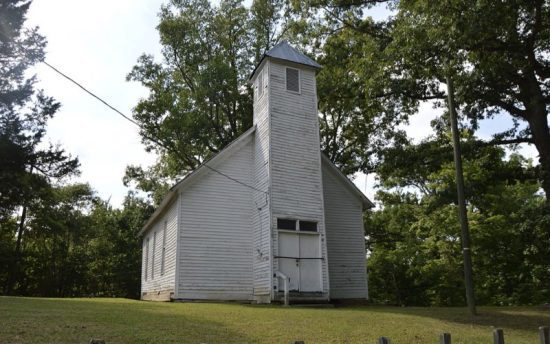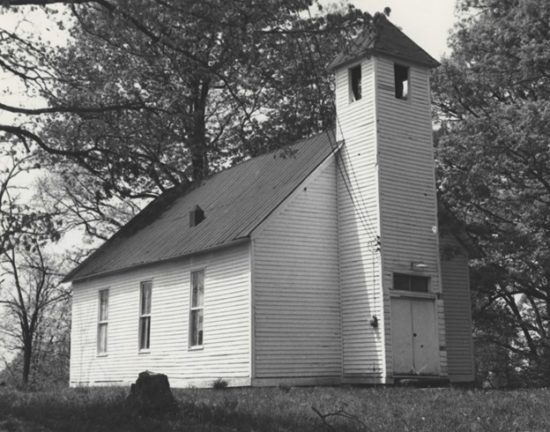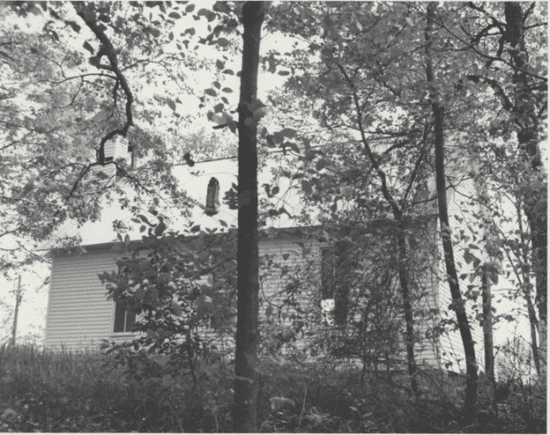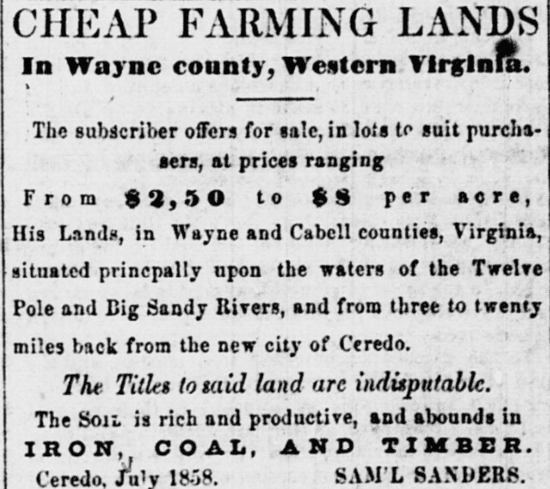
The Providence Baptist Association celebrated its 150th anniversary in 1984. Still, the Burlington Macedonia Church began in 1813 and joined with Union and Big Rock churches in 1821 to form the Providence Anti-Slavery Baptist Association. [Union Church is still active and located near Blackfork.]
The Burlington Macedonia Church building was built in the fall of 1849 on Macedonia Ridge north of Burlington, Ohio, and is the oldest Black church in Ohio. – proven by Carrie Eldridge
The church founders are lost in history, but they were probably the fathers of the men who rebuilt the Macedonia building in 1849.
Charles Roberts was born in 1819 and came to Lawrence County with his father, Pleasant Roberts, in 1827 as one of the manumitted Wards. George Bryant was the son of John Bryant and the grandson of Rosanna Bryant, a freed black woman who owned land in Lawrence County in 1817. Henry King, the son of Sophia King, did not appear on the census lists until 1850, when he was 34 years old. – proven by Carrie Eldridge
In 1827 James Ward of Pittsylvania County, VA, manumitted 134 families and individuals, 48 of whom settled in Lawrence County near Burlington. The Baptist Minister J.J. Craddock and UGRR conductor Phil Lynch were among those settlers. – proven by Carrie Eldridge
The Burlington Macedonia Church is significant as a religious and cultural milestone in the progress of black history in Southern Ohio. Slaves fleeing Virginia plantations before the Civil War traveled the Underground Railroad, many coming to the Burlington area for freedom. In 1849, the ‘Burlington 37′ joined the congregation of the church. One of the freed 37, Thomas Walker Fry, became a famous evangelist.
The Burlington Macedonia Church was placed on the National Historic Register of Historic Places in 1978 and is still standing on Macedonia Road in Fayette Township in Lawrence County, Ohio.
MACEDONIAN ASSOCIATION
Ironton Register, August 20, 1868
Macedonia is an African settlement two miles back of Burlington. It was the scene of great activity during all last week. A colored Baptist Association met there. A score of African divines from far and near was present. On Macedonia hill, the pulpit was erected, and day after day, they poured their simple and rough eloquence to large crowds. Some of them were accomplished ministers and could fill with satisfaction and profit from more pretentious pulpits. – Others, recently from the chains of slavery, spoke in uncouth phrases but with power and vigor.
Last Sunday, between one and two thousand people were on the hill – half of whom were white. – They created an immense stir. A dozen booths with their counters spread with ginger cakes and candies, cheese and bologna, lemonade, and soda water, occupied the most prominent places on the hill. Around these, the sable damsels constantly swayed with their extremely polite escorts.
Many old “aunties,” with bandanas encircling their royal brows, were on hand, with many a soothing word for everyone they met. Perfect equality seemed to crown the entire multitude. White and black, side by side, sipped their lemonade or set under the droppings of the sanctuary.
The Association closed its work Sunday afternoon. The farewell demonstrations were enthusiastic. – A general hand shaking went on around the pulpit while the women kissed and re-kissed each other. It was a gala day for Macedonia.
MACEDONIA CHURCH
Ironton Register, Nov. 21, 1889
MACEDONIA. – The colored people dedicated their new church at Macedonia on the 10th, and what was good about it was every cent of debt was paid when it was dedicated. The church has a membership of over a hundred. It is an old society, having been organized in 1834, and is the mother of five other churches – at Pine Grove, Ironton, Huntington, Catlettsburg, and Burlington. On the day of dedication, 103 were raised, and the church started on its new lease of life square with the world.
National Register of Historical Places – Taken from National Archives Website


Macedonia Church is located two and three-tenths miles north of US Route 52 on Burlington-Macedonia Road and is dated April 10, 1976, from the Ohio Historical Society in Columbus, Ohio. This church occupies 3/4 of an acre, just north of Burlington-Macedonia Road, as it forks to Macedonia Cemetery and Solida Creek [at the top of Charley Creek Road].
Description: The Macedonia Church consists of a one-story rectangular block, approximately 20 x 30 feet, with gable ends at the front and rear. The building is constructed of a frame with beveled siding and rests upon a foundation of short pillars of random coursed field stone.
In the center of the facade is a two-story projecting square bell tower with small rectangular openings of the sash on each side of the upper part of the tower. The original bell and related machinery are visible through the apertures. The roof of the bell tower is four-sided and comes to a point on the top.
The facade, shorter than the sides of the building, is one bay in width. The sides are divided into three bays by three rectangular windows with a double-hung sash and two lights over two lights. The windows have plain surrounds and are surmounted by small rudimentary entablatures. The gabled tin roof has overlapping eaves with no exposed rafters.
The interior retains many of its original 19th-century appointments, such as wooden box pews, stove, and woodwork around windows and the pulpit.
Outbuildings: One-story cinder block restrooms facilities built ca. 1955 are located to the right rear of the church as one faces the building.
Alterations: The church initially had exterior paneled wooden doors. Plain wooden double doors were added ca. 1950. The interior wall surface of rough plaster was covered in recent years by imitation wood paneling wallpaper. The handsome pressed tin ceiling probably dates from the latter 19th century, perhaps having been installed after the building was moved. Three large crystal ceiling lights with red shades were removed approximately 20 years ago. They dated from the 19th century.
Moved: Because of the dampness of the original site, the church was moved approximately 200 yards in 1870.
Significance: The Macedonia Church is significant as a religious and cultural milestone in the progress of black history in Southern Ohio. The church building was built in the fall of 1849 on Macedonia Ridge, north of Burlington, Ohio, which had been an abolitionist sanctuary for runaway and freed slaves since 1799.
In the autumn of 1849, 32 freed slaves arrived in Burlington. They had been part of a larger number of 37 persons emancipated by Virginia planter James Twyman in his will. Twyman had also bequeathed $10,000 to purchase land and homes for the 37 former slaves in one of the free states of this union. The 32 individuals, who came to Ohio, traveled approximately 400 miles from Madison County, Virginia, to Burlington, Ohio, to settle as free people on farmland deeded to them on October 31, 1849.
The new immigrants joined with the existing congregation of the church, organized in 1820, and affiliated with the Providence Association of churches organized in 1830 by Burlington area black religious leaders George Bryant, Charles Roberts, and Henry King. Before 1849 the church members had worshiped in cabins belonging to the individuals in the congregation.
Eli Thayer, Massachusetts abolitionist congressman and founder of Ceredo, (West) Virginia, supplied lumber for the Macedonia Church. The former slaves and their white neighbors carried the lumber across the Ohio River in rowboats, transported it up Macedonia Ridge, and erected the present structure. [Note from The Lawrence Register: this cannot be true as Eli Thayer did not come nor establish Ceredo until 1858-see add below]

The church, which was the black community’s religious and social focal point, became the “mother church” of many other Baptist churches, app. eight of which are still extant in Ohio and West Virginia.
Thus much of the religious foundation of the area was laid. One of the freed 37 slaves, Thomas Walker Fry, a preacher, doctor, and foreman on the Virginia plantation, became a famous evangelist and built a church in Proctorville, Ohio, in 1866.
Other notable personalities connected with the Macedonia Church were: Rev. Ike Bryant, a widely respected minister and speaker, whose services were obtained for the church by Eli Thayer; Eli Justice, who was a trustee of the church when it was moved in 1870; and Eliza Jane Smith, a Sunday school teacher at the turn of the 20th century.
Eliza Jane Smith taught her students the temporal skills of reading and writing and purchased her student’s small gifts for perfect attendance out of her own money.
The Macedonia Church remains today an important reminder of the spiritual idealism and industry of Burlington’s refugees from slavery.
Major Bibliographical References:
- Diane Hagenbach, “Church’s Member Recall ‘Old Days’,” The Herald-Dispatch, Huntington, WV, September 15, 1975, page 10.
- J. Earl Pratt, The Promised Land, Vantage Press, New York, 1964, pp. 16, 17, 18, 26, 27.
- Tod Sedgwick, “Abolitionist History Links Town, Blacks,” The Herald-Dispatch, Huntington, WV, undated.

Nora,
I am trying to find out the names for you, as soon as I locate them I will email you.
Martha
Could you please give me the names of the trustees of the church? They greeted a group of college students I brought to visit from Sinclair Community College in Dayton. They graciously allowed us to enter the church building and spoke with us about the people who originated this body of Christ. I would like to send them a thank you note.
Thanks for pointing that out Carrie, it has been corrected.
Martha
Isaac Vinton Bryant, was born in 1856, a son of William Bryant, a Macedonia minister, and was raised in the Macedonia Church. A well known regional educator, I.V. Bryant was 2 years old when Eli Thayer’s Ceredo village began.
From the same article, Eli Justice was not one of the original “37.”